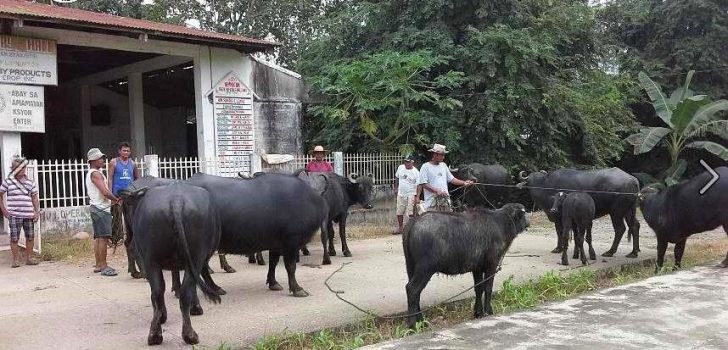
Bigger Market for Dairy Carabao in Cagayan Valley Looms
With the Virgoneza-San Antonio-Sto. Nino-Dabubu FMR in San Agustin, Isabela about to be implemented, the members of the San Agustin Dairy Cooperative (SADACO) have high hopes to boost marketing of their products not only in Isabela but with neighboring provinces. Local farmers too expect easier transport of milk when the road shall have been concreted. SADACO has been the proponent group of the Dairy Carabao Enterprise of Isabela.
“The farm-to-market road will ease the problem of transporting raw milk to the processing center,” he said. “It will also give us an opportunity to sell our products to bigger markets,” SADACO General Manager Joel Cabading revealed during the field documentation conducted by RPCO2 InfoACE and Monitoring and Evaluation Units on April 18, 2018.
Cabading also said that upon installation of the procured equipment for the PRDP funded enterprise, processing will become faster and they can venture into more products.
“The refrigerated van has already been delivered. Once the rest of the equipment will be installed, our operation will be easier and faster,” he said.
The 8.01 kilometers farm-to-market road which amounts to more than 68 million pesos has been put on hold because of problems in Olango-Siempre Viva-Trinidad-Manano FMR in Mallig, Isabela and Magassi-Union-Camasi FMR in Cabagan. All issues concerning the two FMRs have been resolved during the project management meeting on February 20, 2018, and pre-construction conference with the winning bidder was conducted on April 24, 2018, at Balai Conference Hall, Ilagan, Isabela.
Mayor Cesar Mondala of San Agustin expects more development when the farm-to-market road will be finished. He said the PRDP funded FMR will be a great help to farmers who have turned into dairying. The present condition of the road makes it hard for the milk collectors to access dairy farmers in Salay and Sinaoangan.
“We have been waiting for the construction of the farm-to-market road to start. In fact, if you go around, you will notice that we have plenty of crossbred carabaos here. The road will give us easier access to inner barangays. It will benefit our carabao raisers and it will motivate others to venture into dairying. This early, we are thankful to PRDP and the Province for this project,” Mayor Cesar Mondala of San Agustin said.
Ms. Julia E. Andaya, SADACO Chair said the cooperative would double its income once Virgoneza-Salay-Sinaoangan FMR will be completed.
“It will be easier for our buyers to transport milk and volume for processing will be doubled,” she said. “At present, we collect 90-110 liters daily, about 2% only of the total number of lactating crossbred carabaos. Upon improvement of the road, more will be motivated to venture into dairying,” Andaya said. “If we can speed up processing, our products can find their way to bigger markets around the region.”
According to Dr. Kevin Dave Cho, Senior Research Specialist, there are 3,000 heads of Murrah crossbred carabaos in San Agustin in their initial inventory.
“In our estimate, 3,000 is 70% only of the total number. After we shall have the complete number, it will be reflected in our database,” Cho said.
“We have Nuang Festival. If there is an authentic trademark of our town, it is the carabao. In fact, there is an ongoing resolution to make San Agustin the Nuang (carabao) Capital of the Philippines,” Mr. Blas V. Lamug, Municipal Agriculturist said.
Florante de Leon of Salay, San Agustin said he started milking carabao when he was 24 years old. It has been his occupation since.
“From an initial 35 liters per day, I can now sell 50 liters to SADACO. From my income, I was able to send my children to school. My eldest is a graduate of Isabela State University where she finished Bachelor of Science in Business Administration,” he said. SADACO pays him fifty pesos per liter of fresh milk.
Manrico Claro, former SADACO Chair, is also into vermicomposting, aside from raising Murrah bred carabaos.
“There were many challenges since SADACO was organized, especially on carabao raising spearheaded by the Philippine Carabao Center. We were motivated especially when SADACO was formed. We have ever since committed to support CBED, or Carabao Based Enterprise Development,” Claro said.
The crossbred carabaos, according to Mr. Lamug, can produce more milk and has a higher growth rate than an ordinary swamp carabao. San Agustin, with its 19,973 hectares devoted to corn, cassava, and banana with a few paddies of rice fields is located at the hilly boundaries between Quirino and Aurora. The rolling terrain abounds with grasses which provide ready forage for carabaos.
“Our farmers use the carabaos to haul harvest and plow the fields before. When the Carabao Upgrading Program was introduced, they tried to crossbreed their carabaos. Slowly, dairying was introduced. They can now see the difference, as they can use these beasts of burden for draft power to haul harvest, plow the field and dairying,” Mr. Lamug said.
As the construction of the farm-to-market road is being looked forward to by the residents of San Agustin, it could not be denied that the Dairy Carabao Enterprise will also carve its name in the town’s history. (Ferdinand N. Cortez, RPCO2 InfoACE)
